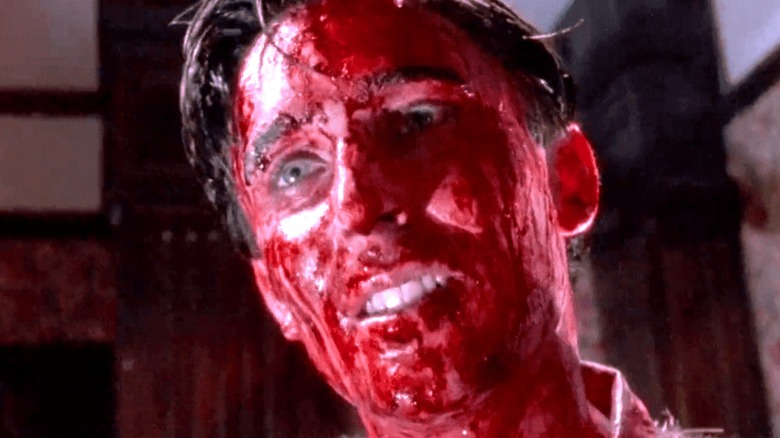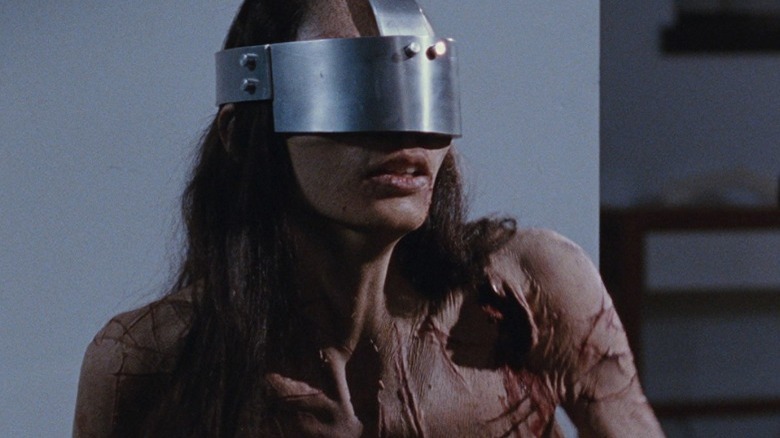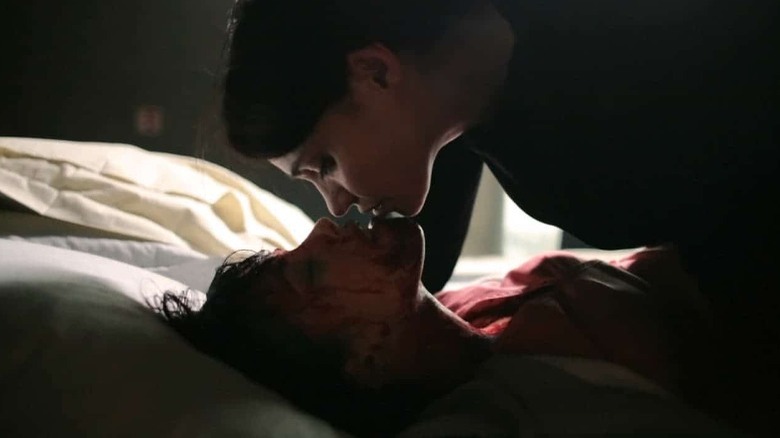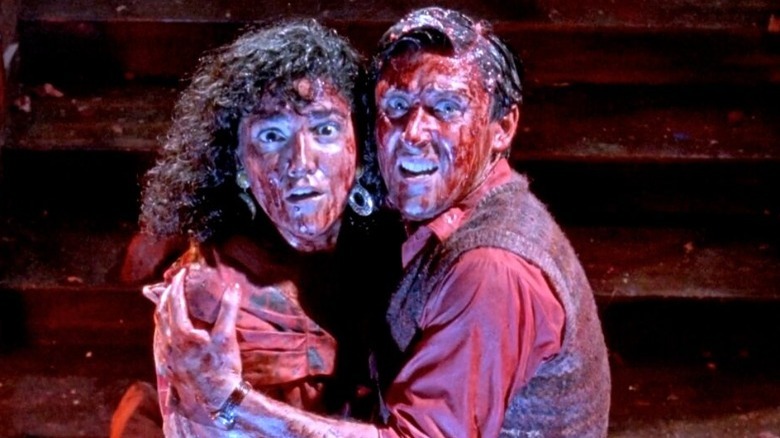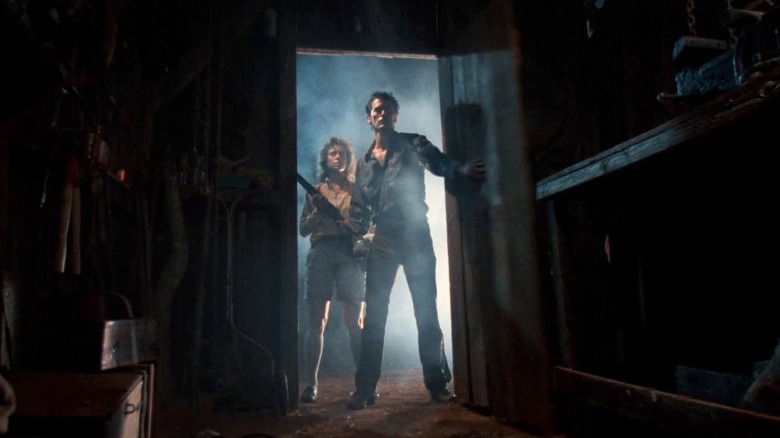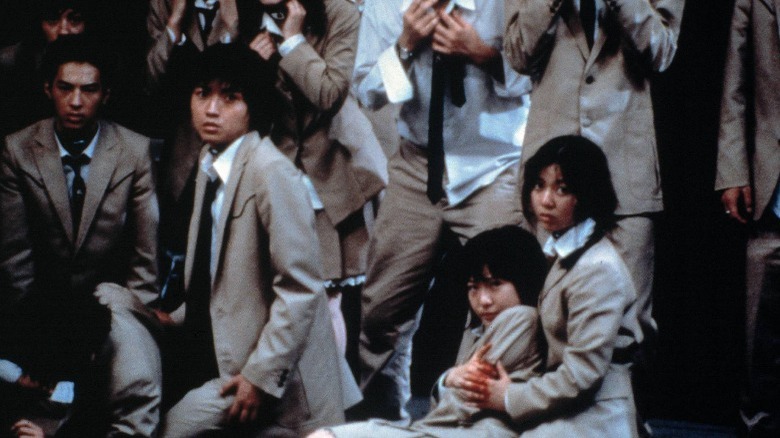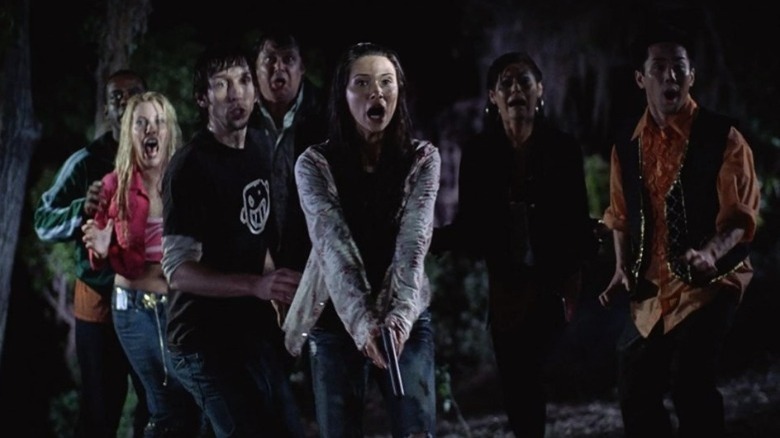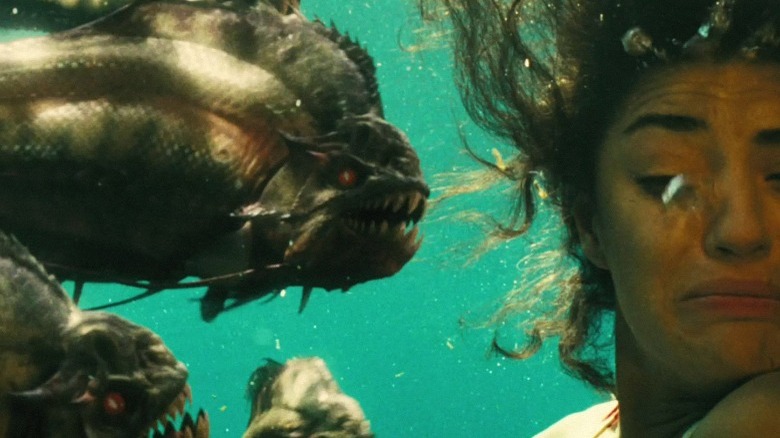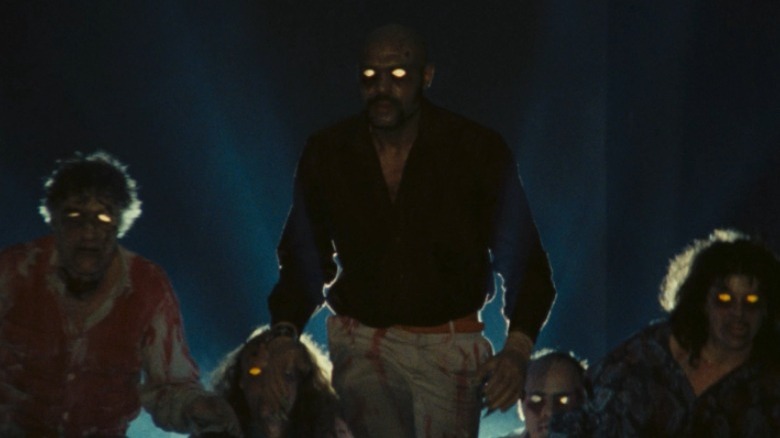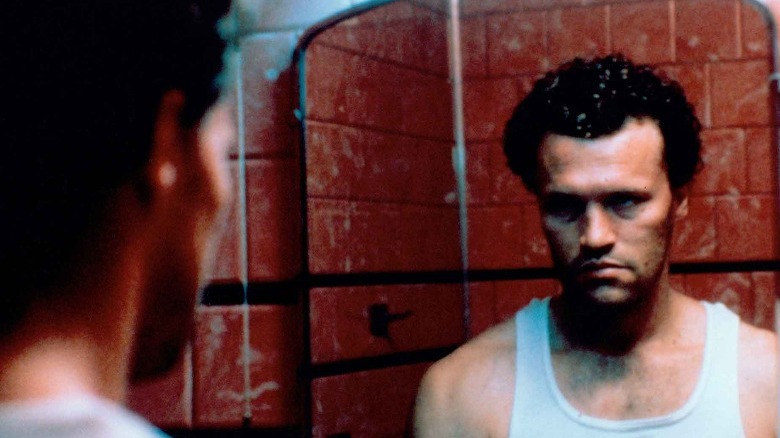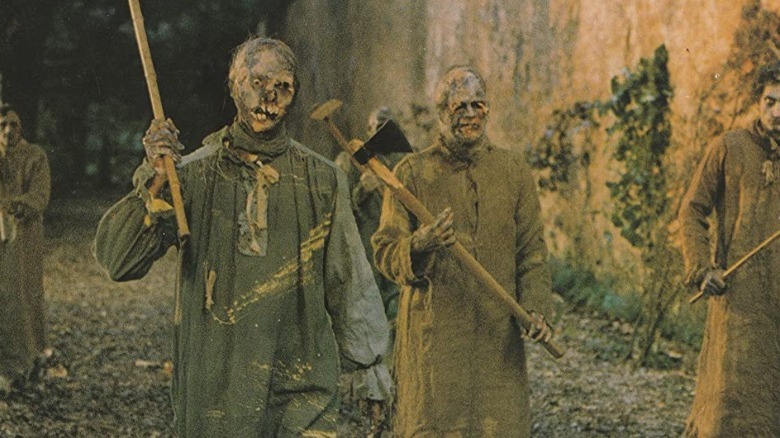The 10 Goriest Horror Movies Ever Made
Gore is not for everyone, not even all horror aficionados. For many viewers, a few severed limbs and disembowelment go a long way. Outside of the horror community, "gore" is almost a pejorative — to some people, horror movies are splatter flicks, full stop.
That isn't true, of course. Horror is diverse and haunting and enduring, and though there is some merit to the argument that gore can compensate for failures elsewhere, it's also an artform in and of itself. For filmmakers like Tom Savini, Greg Nicotero, and Eryn Mekash, gore is paint, and film is their canvas. In the right hands, blood and guts can be a poetic, violent, boundary-pushing interrogation of global ailments and a curative, crimson expression. After all, wounds are healed when blood is spilled.
In our opinion, the following movies are the goriest ever made. With only 10 to choose from, not every bloodbath could make the list, but whether it's an old classic or a newer gem, these are the movies whose gore is rendered so consistently and effectively that it transcends. Beware of spoilers!
Martyrs
Pascal Laugier's "Martyrs" is not for the faint of heart. Lucie (Mylène Jampanoï) and her friend, Anna (Morjana Alaoui) invade the Belfonds' family home, a rural country estate nestled in the French countryside. Ostensibly a normal family, Lucie nonetheless believes that the Belfonds are responsible for her adolescent capture and torture. Plagued by nightmares and enduring reminders of her kidnapping, Lucie believes that killing the Belfonds will free her — but Anna is considerably less convinced.
Subversive, gritty, and featuring some of the genre's most painful gore effects, including exploding heads and an extended sequence of a human being flayed alive, "Martyrs" is a benchmark for the genre. With an existential narrative and a genuine grounding for its uber-violence (the title holds dual meanings), "Martyrs" is unlike anything you've seen before. It's a contemporary classic, and the movie that put Laugier on the map. In addition, "Martyrs" is elevated by its gore, not compromised. Just ask fans of the remake. When the violence is dulled, so too is the narrative's impact.
Inside
New French Extremity is a term coined by Artforum critic James Quant to elucidate upon the trend of violent, transgressive cinema of the 21st century, driven largely by French auteurs. Though Quant was principally concerned with the early '00s, the legacy of New French Extremity endured long into the decade, famously encompassing both "Martyrs" and "Inside." The latter film, the debut feature from duo Julien Maury and Alexandre Bustillo (who also made "The Deep House" and "Kandisha"), is bare bones savagery at its best.
Expecting mother Sarah (Alysson Paradis) is spending Christmas Eve alone, having survived a crash in which her husband was killed. Luckily, both she and the baby lived. Late at night, a woman (Béatrice Dalle) — or, as she's known, the woman — breaks in, hellbent on cutting Sarah's baby right out of her. Maury and Bustillo make great use of conventional domestic products, including scissors, knitting needles, and aerosol, as Sarah locks herself in the bathroom and the woman kills anyone unlucky enough to stop by.
There's little more to "Inside" than that, although the movie does attempt to tackle some dour themes about the fears new mothers face. Still, audiences flocked to "Inside" on account of its increasingly blood-soaked kills. The deaths hit hard, eschewing conventional Hollywood crimson for sticky, viscous blood and viscera. "Inside" is painful to watch, yet that pain cements its legacy. Over the course of this century, no one has made gore quite as artful as Maury and Bustillo, and "Inside" shows them at their best.
Dead Alive
Seongyong Cho, writing for Roger Ebert, calls "Dead Alive," one of the "most disgusting movies ever made." A box office bomb that nonetheless attracted a significant cult following, it is one of director Peter Jackson's (yes, that Peter Jackson) most accomplished movies. A hybrid of early Raimi and late Carpenter, "Dead Alive" follows Lionel (Timothy Balme), a young man who lives with his overbearing, suitably Gothic mother, Vera (Elizabeth Moody). She follows Lionel and his love interest, Paquita (Diana Peñalver) to the Wellington Zoo, and is soon after bitten by a gruesome combination of a rat and a primate. Vera transforms into a zombie, and as overbearing mothers are inclined to do, soon infects large swaths of the townsfolk. Lionel is in a heap of trouble.
Well-choreographed and filmed with a grindhouse sensibility — and a wicked sense of humor — "Dead Alive" (also known as "Braindead") is a rollicking good time. Entrails are spilled, bodies are torn asunder, and in the middle of it all is a hapless young adult just looking for love and a good time. "Dead Alive" is sublimely tasteless in its violence, and all the better for it. The zombie subgenre had little momentum in the '90s, yet like a mad scientist, Jackson brought it back from the dead.
Evil Dead II
It all comes back to the chainsaw arm. Sam Raimi's "Evil Dead II" is exceptionally accomplished on all fronts, but even among non-fans, Bruce Campbell's chainsaw arm is iconic not just in the series, not just in horror, but in cinema writ large. Here, Campbell once again plays Ash, first reenacting the events of the original "Evil Dead," a supremely gory and stylish horror film in its own right, before pushing the film into new territory. In Campbell's own words, "Evil Dead II" is more of a "requel" than a direct sequel, merging conventional sequel sensibilities with backing and budget of a studio film.
Ash travels to a remote cabin with his girlfriend, Linda (Denise Bixler while alive, Snowy Winter in demonic form), where he plays a tape with a recorded passage from the legendary Necronomicon Ex-Morris, unleashing a torrent of demonic activity that possesses Linda. In the ensuing struggle, Ash decapitates Linda and loses his own hand, later replacing his lost limb with a chainsaw for maximum carnage. Other passersby stop in, including the archeological team that originally discovered the book, and so, so much blood is spilled.
Funnier and more meta than the first movie, "Evil Dead II" cemented Evil Dead as its own franchise, which later expanded to include a sequel, a remake, a television series, comics, video games, and more. This demon just won't — and shouldn't — die.
Battle Royale
"Battle Royale" is a Japanese horror-action hybrid and the last directorial outing for filmmaker Kinji Fukasaku, who passed away three years later while working on the sequel, "Battle Royale II: Requiem." A precursor to "The Hunger Games," "Battle Royale" tracks Japanese high schoolers living under a totalitarian regime in the near future. The kids are gassed and taken to a remote island, where they're told they have three days to kill one another — there will be only one winner. Explosive collars, not unlike those in "The Belko Experiment," have been strapped to their necks, set to detonate when students refuse to cooperate or try to flee.
Though Tatsuya Fujiwara's Shuya and Aki Maeda's Noriko are the ostensible protagonists, "Battle Royale" follows the entire class. Some children are eager to spill blood. Others are unwilling or unable. Either way, blood is spilled, and it's spilled in earnest. There are sword fights, shoot outs, and, yes, exploding heads.
Banned in several countries — the United States didn't see a physical release until 2010 — the violence in "Battle Royale" is just as disturbing as its general conceit, although there's a strong thematic foundation for all of the gore. "Battle Royale" is a classic for good reason. For audiences who can handle its savagery, it's worth fighting for.
Hatchet
"Hatchet" is the first of four Victor Crowley slashers from director Adam Green. As the Bayou Butcher, Victor Crowley (Kane Hodder, of Jason Voorhees fame) is rumored to haunt a deserted section of New Orleans wilderness, killing anyone who enters his domain. When a haunted tour boat has an accident, a menagerie of tourists and filmmakers — and one survivor, named Marybeth Dunston (Tamara Feldman) — find themselves trapped in a nightmare. As they discover, the legend of Victor Crowley is completely true.
The Victor Crowley series has little on its mind other than carnage. The three additional sequels expand the mythology, and though there's something noteworthy about Dunston's attempts to stop Crowley (in later installments, she's played by genre favorite Danielle Harris), "Hatchet" is all about the deaths. People are torn apart, ground down with sanders, and beheaded so graphically that even the most steadfast genre fans are liable to wince.
More than mere homage to the carnage of slashers past, there's artistry to Green's killings, and while later entries grow more violent and cartoonish, the original "Hatchet" still hasn't been topped. Funny, scary, and exceptionally gory, "Hatchet" will endure as a modern horror classic.
Piranha 3D
"Piranha 3D" is currently sitting at 74% on Rotten Tomatoes. Yes, a movie about prehistoric piranhas rising from a chasm at the bottom of an Arizona lake and chowing down on anything in their path is certified fresh. More accomplished than the original, sequel, or its many remakes and imitators (the original "Piranha" was itself a low-budget "Jaws" rehash), "Piranha 3D" has little more on its mind than exploitive carnage. Half the cast spends the entire movie mostly (or entirely) nude, and if you thought that director Alexandre Aja was going to limit the gore to fish taking bites out of spring breakers, you'd be wrong.
Tourists are sliced in half by errant wires and scalped by boat motors, and in one infamous scene, Jerry O'Connell has his manhood bitten off. 80,000 gallons of blood were used for the movie's climactic massacre, during which thousands of piranhas go to town on a lake full of spring breakers. The chaos is as artfully and poetically crafted as anything I've ever seen. Yes, it is violence for violence's sake, but when it's rendered with this much love, care, and attention to detail, it doesn't matter. Just steer clear of the sequel, "Piranha 3DD." The title says it all.
Demons
"Demons" is a giallo powerhouse. The hallmarks are all there: lurid lighting, extreme violence, questionable behavior, and fantastic supernatural occurrences. Directed by Lambarto Bava, son of famous Italian gore hound Mario Bava (see: "A Bay of Blood"), "Demons" follows two female university students and several other people who are invited to a mysterious movie screening where they find themselves locked inside a theater with a bunch of demons.
"Demons" isn't the greatest giallo there is, though it does rank among the most violent. Not just bloody, "Demons" is gross in the best ways possible. People are mutilated, dismembered, scalped, stabbed, and ripped apart at such an alarming pace that it's easy to lose track who's left alive. Erected with pristine Gothic sensibilities — exterior shots were filmed at the Metropol cinema in Berlin — "Demons" is a consistently entertaining grab-bag of familiar horror movie elements made, thanks to the gore, as shocking as possible.
Henry: Portrait of a Serial Killer
"Henry: Portrait of a Serial Killer" isn't simply one of the scariest movies ever made, it's also one of the goriest — a feat it achieves by virtue of a single scene during the film's 83-minute runtime. Henry (Michael Rooker, playing a character largely believed to be real-life serial killer Henry Lee Lucas) has killed his friend and roommate, Otis (Tom Towles, basing his character on Ottis Toole). He is seen carving Otis's body in the bathtub. The lighting is stark, the setting grim, and the verisimilitude nauseating. It feels as if audiences are watching an actual man being carved up, and it's terrifying.
The snuff-film elements aren't limited to just that scene. Different cuts of the movie vary, on account of severe censorship in both the United States and abroad, but in brief vignettes, there are shots of bloated bodies on the shore, naked women with bottles shoved down their throats, and an extended home video sequence in which Henry and Otis murder an entire family. Controversial to this day, the violence in "Henry: Portrait of a Serial Killer" doesn't feel cinematic. It feels real.
Burial Ground
Luckily, "Burial Ground" is considerably lighter than "Henry: Portrait of a Serial Killer." In part, that's because "Burial Ground" isn't very good. With regard to basic elements like story, acting, and cinematography, "Burial Ground" falls short. Its title alone is a wild saga — directed by Andrea Bianchi, "Burial Ground" was released as "Nights of Terror," "Zombi Horror," "The Zombie Dead," and "Zombi 3," and is one of several films marketed as a sequel to George Romero's "Dawn of the Dead."
"Burial Ground' follows a ragtag group of survivors who outrun a zombie apocalypse that is unleashed when a scientist falls afoul of an evil curse. Little that follows amounts to much. "Burial Ground" is cheap, grainy, and poorly conceived.
A decades-old Italian zombie flick, though, doesn't simply reanimate and endure for nothing. In addition to everything else, "Burial Ground" is ludicrously violent. A woman has her nipple bitten off. Heads are sliced off with scythes. Necks are torn asunder, and heads are crushed against bathtubs. What "Burial Ground" lacks in artistry and narrative cohesion it makes up for in sheer carnage.
